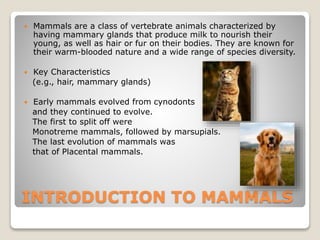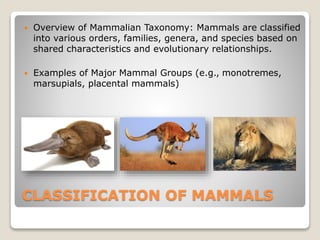DIVERSITY _OF MAMMALS _Presentaion_.pptx
- 1. DIVERSITY OF MAMMALS BULBUL HOQUE B.Sc 3rd Sem ROLL NO. : US-221-099-0060 SUBJECT: ZOOLOGY
- 2. INTRODUCTION TO MAMMALS ’éŚ Mammals are a class of vertebrate animals characterized by having mammary glands that produce milk to nourish their young, as well as hair or fur on their bodies. They are known for their warm-blooded nature and a wide range of species diversity. ’éŚ Key Characteristics (e.g., hair, mammary glands) ’éŚ Early mammals evolved from cynodonts and they continued to evolve. The first to split off were Monotreme mammals, followed by marsupials. The last evolution of mammals was that of Placental mammals.
- 3. CLASSIFICATION OF MAMMALS ’éŚ Overview of Mammalian Taxonomy: Mammals are classified into various orders, families, genera, and species based on shared characteristics and evolutionary relationships. ’éŚ Examples of Major Mammal Groups (e.g., monotremes, marsupials, placental mammals)
- 4. ADAPTATIONS FOR SURVIVAL ’éŚ Behavioral and Physical Adaptations: Mammals have evolved a variety of adaptations for survival, including behaviors like burrowing or migration and physical features such as specialized teeth or claws. ’éŚ Examples of Unique Mammalian Features (e.g., echolocation in bats, hibernation)
- 5. MAMMALS IN ECOSYSTEMS ’éŚ Role of Mammals in Food Webs: Mammals play essential roles in terrestrial and aquatic ecosystems, often as consumers or predators, contributing to the balance of these systems. ’éŚ Impact on Ecosystems (e.g., seed dispersal, predator-prey relationships)
- 6. CONCLUSION ’éŚ In closing, we've explored the fascinating world of mammals, a class of animals defined by their unique characteristics, including fur, mammary glands, and warm- bloodedness.We delved into the classification of mammals, from monotremes to marsupials and placental mammals, highlighting their incredible diversity. ’éŚ Moreover, we've seen how mammals play pivotal roles in ecosystems, influencing everything from seed dispersal to complex predator-prey relationships.
- 7. THANK YOU






